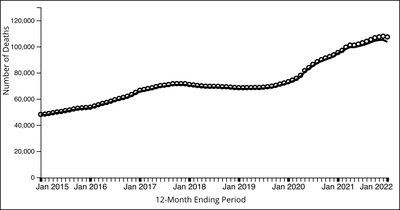U.S. Overdose Rates Rise Again in 2021, But at a Slower Pace

The Centers for Disease Control and Prevention keeps a close eye on public health and safety threats, as is their mandate.1 One of the most prominent threats to American health in the last two decades has been drug overdoses. In fact, the drug fentanyl has become the leading cause of death among Americans between the ages of 18 and 45.2
Alarm bells are ringing across public health and research sectors from the east coast to the west and everywhere in between. Drug-related fatalities continue to rise, with no apparent end in sight. Yet drug overdoses are preventable, and there are effective tools for combating drug addiction.
A 30 Percent Increase in 2020, A 15 Percent Increase in 2021
The CDC’s provisional data for 2021 indicate that 108,000 Americans lost their lives to drug overdoses that year. That figure is up 15% from the 93,000 drug-related deaths that occurred in 2020, which itself represented a 30% spike from the 72,000 overdose deaths that occurred in 2019.3

Courtesy of CDC.gov
According to the National Safety Council, poisonings, the vast majority of which are caused by drug overdoses, are the leading cause of preventable death in the U.S., accounting for 43% of all preventable fatalities.4 But it’s not just preventable deaths in which drug overdoses rank high. When the lens is zoomed out to examine all fatalities, drug overdoses are still in the top ten list for leading causes of death in America.5
There is no doubting the American people have an epidemic of drug addiction and overdose on their hands. However, the problem is not as complicated as one might think. There are just a few, albeit serious, reasons why this perfect storm has descended upon the nation at this time.
Illicit Fentanyl, A Major Culprit in Overdose Deaths
Fentanyl, a powerful synthetic opioid that the Drug Enforcement Administration labels as being 50-100 times more potent than morphine and about ten times stronger than heroin, has spread into the drug supply and contaminated countless batches of drugs. Dealers often mix fentanyl into other drugs without buyers knowing, hoping to get addicts hooked on an even more potent (and more expensive) drug.6
The National Institute on Drug Abuse’s director, Dr. Nora Volkow, has warned the American people for some time about the threat of fentanyl. In her words, “Drug dealers made a lot of money, and there’s no incentive for them to stop. As a result of that, we have seen an increase, a very dramatic increase, in the distribution of fentanyl across all of the United States. The drug market and the drug supply right now is very, very dangerous because of the increasing frequency with which it is contaminated with fentanyl. You have a much greater risk of overdosing and dying if you take drugs currently than, say, ten years ago.” Sadly, fentanyl accounted for more than 71,200 deaths in 2021, compared with 57,800 in 2020, a significant increase.7
Difficult Social and Economic Circumstances Exacerbate the Problem

Another aspect of the perfect storm has been that, just as fentanyl began to spread across the nation and make the drug supply much more dangerous, the Covid-19 pandemic struck, coupled with economic devastation for millions of Americans. It is well known that harsh social conditions, lack of opportunity, and economic deprivation set the stage for drug abuse as a coping mechanism. Further, other common predictors of drug abuse, like trouble in the family or feelings of personal failure, can themselves be the byproducts of economic and social strife.
It’s no coincidence that drug overdoses spiked in 2020 and 2021. Even the National Safety Council, an organization similar to the CDC and tasked with protecting American life, has listed the Covid-19 pandemic as an event that led to many other public health crises. Quoting their documentation, “A likely byproduct of the overall disruptions and stress induced by the COVID-19 pandemic, preventable opioid overdose deaths increased 41% in 2020.” 8
Prevention and Rehabilitation Are Not Available to Most Addicts
Public health officials, policymakers, and many American families understand what causes addiction, why addiction and overdoses are spiking, and what should be done to solve the problem. The answer is drug treatment, but sadly there is a huge gap between those who need effective treatment and those who receive it.
This gap has developed for numerous reasons, one of which is the negative stigma still associated with addiction. Quoting Dr. Volkow, “Instead of taking the opportunity to do an intervention to prevent, just like we do an intervention to prevent diabetes, the health care system has ignored, or neglected substance use disorder, and people do not realize that this is something that can be prevented and treated." Overcoming the social stigma connected to addiction will be a significant first step in making treatment available to addicts.
Beyond the continuing negative stigmatization of addicts, there are many other reasons why millions of Americans need treatment but don’t receive it. Until these reasons are addressed and overcome, the status quo will likely continue, and only one in ten Americans who need help for a drug problem will ever receive help.9
Key Takeaways
If every American could go out and approach the nation’s drug epidemic with five key takeaways from this article, they would be the following:
-
Fentanyl is a leading cause of increasing drug overdoses.
-
Difficult social circumstances (like a pandemic coupled with an economic recession) press people into drug abuse as a coping mechanism.
-
Yet, prevention and education efforts are effective in curbing addiction rates.
-
Making addiction treatment available to all who need it is the linchpin to overcoming the addiction crisis.
-
Supporting people in their sobriety once they complete treatment and reenter society is also very important.
Addiction is a devastating crisis that continues to claim tens of thousands of American lives each year. It is a public health emergency that shows no sign of letting up unless the American people collectively do something about it. Thankfully, effective tools do exist for combating the problem. Residential drug rehab programs work for those already addicted. And prevention efforts have proven successful in helping stop people from becoming hooked on drugs before they even start experimenting.
We must utilize these interventions, and it is the responsibility of every American to ensure they are utilized. Hundreds of thousands of lives depend on it.
Sources:
-
Daily Advance. “Greg Murphy: Fentanyl crisis demands attention, border security.” Daily Advance, 2022. dailyadvance.com ↩︎
-
CDC. “Provisional Drug Overdose Death Counts.” CDC, 2022. cdc.gov ↩︎
-
NSC. “Top Ten Preventable Injuries.” NSC, 2021. injuryfacts.nsc.org ↩︎
-
NSC. “All Leading Causes of Death.” NSC, 2021. injuryfacts.nsc.org ↩︎
-
USNews. “U.S. Fatal Drug ODs Rose Again in 2021, But Increase Is Slowing.” USNews, 2022. usnews.com ↩︎
-
NSC. “Drug Overdoses.” NSC, 2021. injuryfacts.nsc.org ↩︎
-
NIDA. “Principles of Drug Addiction Treatment: A Research-Based Guide (Third Edition).” National Institute of Drug Abuse. 2014. nida.nih.gov ↩︎






 ®
®